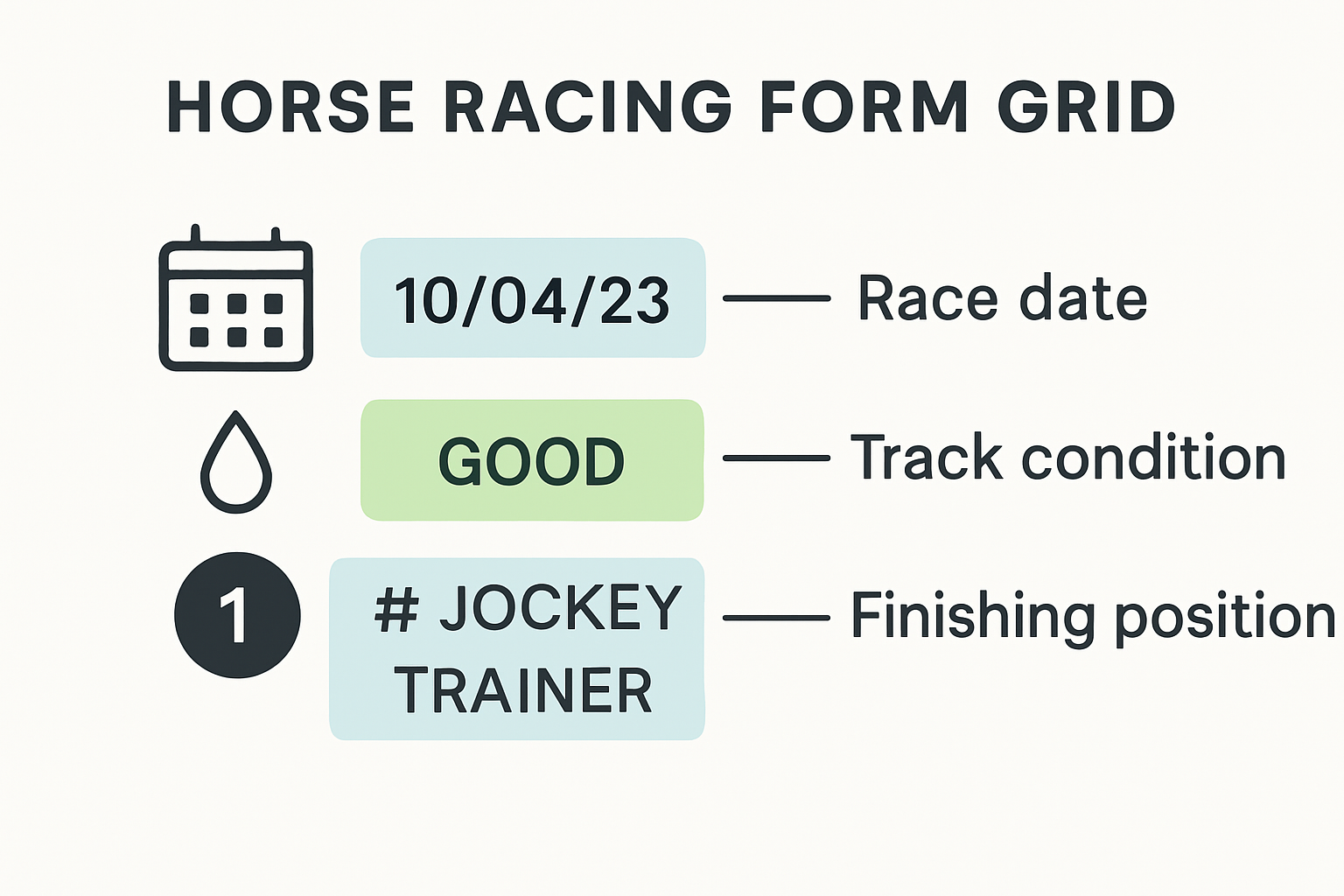Serious horse bettors know that understanding racing form is supposed to be the big secret to picking winners. Yet almost nobody realizes how much subtlety there is in this sea of tiny numbers and symbols. Take this for example—one misplaced symbol can flip your bet from a strong favorite to a total longshot. Most guides just scratch the surface but there are hidden details that even seasoned bettors keep missing.
Table of Contents
- Understanding The Basics Of Race Form
- Decoding Key Horse Racing Stats And Symbols
- Expert Tips To Compare Horses And Spot Winners
- Common Mistakes When Reading Racing Form
Quick Summary
| Takeaway | Explanation |
|---|---|
| Understand race form essentials | Familiarize yourself with key elements like race date, track condition, and finishing position for informed betting. |
| Master race symbols and stats | Learn to interpret symbols such as ‘1’ for wins and ‘P’ for pulled-up to gauge horse performance quickly. |
| Employ advanced comparison techniques | Analyze factors like recent form and jockey compatibility to enhance your horse assessment skills. |
| Avoid common betting mistakes | Watch out for misinterpretation of stats and overlook crucial contextual factors that influence outcomes. |
| Take an analytical approach | Balance emotional instincts with systematic analysis to improve your betting strategies and decisions. |
Understanding the Basics of Race Form
Reading horse racing form is a critical skill for bettors seeking to make informed wagering decisions. The racing form provides a comprehensive snapshot of a horse’s performance history, offering crucial insights that go far beyond simple win-loss records.
Decoding the Performance Grid
The racing form presents a complex grid of information that might initially seem overwhelming. The Jockey Club explains that each row typically represents a previous race, with key data points that help bettors assess a horse’s potential performance.
Critical elements in the performance grid include:
- Race Date: Indicates when the horse last competed
- Track Condition: Shows performance across different racing surfaces
- Finishing Position: Reveals the horse’s placement in previous races
- Jockey and Trainer: Provides insight into the horse’s professional support team

Understanding these elements requires careful analysis and pattern recognition. Professional bettors spend significant time studying these details to identify trends and potential advantages.
Interpreting Race Symbols and Abbreviations
Wikipedia’s horse racing form guide highlights the importance of understanding the symbolic language used in racing forms. Different symbols represent various race outcomes and performance characteristics.
Common symbols include:
- ‘1’ indicates a first-place finish
- ‘2’ represents a second-place result
- ‘0’ or ‘-’ might signify a performance below the top positions
- ‘P’ could indicate the horse was pulled up during the race
These symbols provide a quick visual representation of a horse’s competitive history. Experienced bettors can quickly scan these symbols to assess a horse’s consistency and potential in upcoming races.
Mastering horse racing form reading is not an overnight skill. It requires patience, practice, and a willingness to dive deep into performance data. While the form might look like a complex matrix of numbers and symbols, it tells a story of each horse’s racing journey.
By learning to read these intricate details, bettors can transform raw data into strategic insights, improving their chances of making more informed betting decisions. The racing form is more than just a record it is a powerful tool for understanding equine athletic performance.
Decoding Key Horse Racing Stats and Symbols
Navigating the complex world of horse racing stats requires understanding a unique language of symbols and abbreviations. Wikipedia’s racing form guide reveals that these cryptic notations provide critical insights into a horse’s performance history and potential.
Performance Indicators and Race Symbols
Race symbols serve as a shorthand communication system for bettors. According to racing documentation, these symbols quickly communicate a horse’s past race outcomes and critical performance details.
Key performance symbols include:
- ‘1’: First place finish
- ‘2’: Second place result
- ‘0’ or ‘-’: Performance outside top positions
- ‘P’: Horse pulled up during race
- ‘F’: Horse fell during the race
- ‘R’: Horse refused to continue
- ‘U’: Rider unseated
Professional bettors view these symbols as a sophisticated storytelling mechanism that reveals a horse’s competitive temperament, physical condition, and racing consistency.
Below is a table summarizing the most common horse racing form symbols and their meanings for quick reference:
| Symbol | Meaning |
|---|---|
| 1 | First place finish |
| 2 | Second place result |
| 0 / – | Outside top positions |
| P | Pulled up during race |
| F | Fell during race |
| R | Refused to continue |
| U | Rider unseated |
Advanced Statistical Analysis
Beyond basic symbols, horse racing forms contain nuanced statistical data that demands careful interpretation. Sophisticated bettors look beyond simple win-loss records to understand deeper performance metrics.
Complex indicators help bettors learn advanced betting strategies. These include:
- Course Performance: Indicates how a horse performs on specific track types
- Distance Records: Shows effectiveness across different race lengths
- Jockey Compatibility: Reveals horse’s performance with specific riders
Mastering these statistical nuances transforms raw data into strategic betting insights. Each symbol and number represents a chapter in a horse’s competitive narrative, offering discerning bettors a comprehensive view of potential race outcomes.
Understanding these intricate details requires patience, practice, and a willingness to learn the unique language of horse racing statistics. By developing this skill, bettors can move from guesswork to informed decision-making, significantly improving their wagering strategies.
Expert Tips to Compare Horses and Spot Winners

Successful horse race betting demands more than casual observation. Professional bettors employ sophisticated strategies to compare horses and identify potential winners, transforming raw data into strategic insights.
Comparative Performance Analysis
Gamble Road’s expert guide emphasizes the critical importance of comprehensive performance comparison. Bettors must look beyond simple win-loss records and analyze nuanced performance metrics.
Key comparative factors include:
- Consistent Performance: Track record of steady results
- Recent Form: Performance in last 3-4 races
- Track Adaptability: Success across different racing conditions
- Weight Carried: Impact of assigned racing weight
Professional handicappers meticulously examine these elements, understanding that each data point tells part of a horse’s competitive story.
The following table organizes essential comparative factors bettors use to assess horses’ chances in a race:
| Comparative Factor | What to Analyze |
|---|---|
| Consistent Performance | Steady results over time |
| Recent Form | Performance in last 3-4 races |
| Track Adaptability | Success on different surfaces |
| Weight Carried | Effects of assigned racing weight |
| Class Level Evaluation | Results within specific racing classifications |
| Jockey Compatibility | Rider-horse past performance |
| Pace Analysis | Racing speed and energy patterns |
Advanced Comparative Techniques
Wikipedia’s racecard insights reveal sophisticated methods for horse comparison. Experienced bettors develop a multi-dimensional assessment approach that goes beyond surface-level statistics.
Advanced comparison strategies include:
- Class Level Evaluation: Assessing performance within specific racing classifications
- Pace Analysis: Understanding a horse’s racing speed and energy distribution
- Jockey-Horse Compatibility: Examining rider’s historical performance with specific horses
These techniques transform statistical analysis into predictive modeling, allowing bettors to make more informed wagering decisions.
Spotting Hidden Potential
Spotting potential winners requires looking beyond obvious performance indicators. Betting analytics can help identify horses with overlooked competitive advantages.
Key strategies for identifying potential winners include:
- Subtle Performance Trends: Recognizing incremental improvements
- Training Reports: Analyzing pre-race conditioning and preparation
- Track-Specific Strengths: Understanding unique performance characteristics
Successful horse race betting is part science, part art. By developing a comprehensive, analytical approach to horse comparison, bettors can significantly improve their chances of identifying winning horses and making strategic wagers.
Remember, no method guarantees success, but systematic analysis dramatically increases the probability of making informed betting decisions.
Common Mistakes When Reading Racing Form
Reading horse racing form requires precision and strategic thinking. Even experienced bettors can fall into predictable traps that compromise their betting decisions. Betfair’s educational resources highlight the complexity of interpreting racing statistics accurately.
Misinterpreting Statistical Performance
Before You Bet emphasizes that bettors often make critical errors when analyzing performance data. Common statistical misinterpretations include:
- Overvaluing Win Percentages: Focusing solely on total wins without context
- Ignoring Track Conditions: Failing to consider how different surfaces impact performance
- Misreading Recent Form: Assuming recent performance guarantees future success
Professional handicappers understand that statistics tell a nuanced story. Each number represents a complex combination of factors that cannot be simplified into basic win-loss records.
Overlooking Contextual Performance Factors
Horise’s guide reveals critical contextual elements that inexperienced bettors frequently ignore. These overlooked factors can dramatically impact race outcomes.
Key contextual considerations include:
- Barrier Placement: Understanding how starting position influences race strategy
- Jockey Changes: Recognizing the impact of rider switches on horse performance
- Race Class Transitions: Evaluating how horses perform when moving between different racing categories
Most bettors fixate on surface-level statistics, missing the intricate details that separate successful wagers from random guesses.
Emotional Betting Traps
Discover essential betting strategies that help avoid emotional decision-making. Bettors frequently fall into psychological traps that cloud rational analysis:
- Chasing Past Glory: Betting on horses based on nostalgic past performances
- Favorite Bias: Consistently overvaluing top-ranked horses
- Ignoring Long-Term Trends: Focusing on short-term results instead of comprehensive performance history
Successful horse race betting demands a disciplined approach. Emotional reactions and simplistic interpretations of racing form can lead to consistent losses. By developing a methodical, analytical approach, bettors can transform their understanding of racing statistics.
Remember, reading racing form is an art and a science. It requires patience, critical thinking, and a willingness to look beyond obvious statistical indicators.
Frequently Asked Questions
What is horse racing form, and why is it important for bettors?
Horse racing form is a record of a horse’s past performances, including race finishes, track conditions, and other critical statistics. It’s important for bettors because it helps them assess a horse’s potential and make informed wagering decisions.
How do I decode the performance grid in horse racing form?
The performance grid includes key elements like race date, track condition, finishing position, and the horse’s jockey and trainer. Each row typically represents a previous race, allowing bettors to analyze patterns in performance.
What do common race symbols mean in horse racing form?
Common race symbols include ‘1’ for a first-place finish, ‘2’ for second, ‘P’ for pulled up, ‘F’ for fell, and ‘U’ for rider unseated. These symbols provide a quick visual reference to a horse’s historical performance.
What are some common mistakes bettors make when reading racing form?
Common mistakes include misinterpreting statistical performance by overvaluing win percentages, overlooking contextual performance factors like barrier placement and jockey changes, and falling into emotional betting traps such as favorite bias.
Ready to Turn Horse Racing Knowledge Into Winning Bets?
Many bettors struggle with the complexity of reading horse racing form. You have just learned how subtle details and symbols can change everything about your wagering strategy. At Betco AG, we know that transforming raw data into real betting success requires the right tools and up-to-date insights. Want to go beyond the basics and apply what you’ve learned using the best resources for smarter bets? Start with our Sports Betting Guides and Resources for deeper tips and strategies designed specifically for horse racing and other sports.

Take action today. Discover how an advanced betting hub with strong responsible gaming policies and wide-ranging support can enhance your form reading skills and help you bet with confidence. Experience all the features Betco AG offers by visiting Betco AG now and start applying your newfound knowledge where it matters most.
Recommended
- General Tips for New Bettors: Essential Advice for 2025 – Betco
- How to Bet on Sports: A Beginner’s Guide | Betco Sports
- How to Bet on MLB in 2025: Guide for Smart Bettors – Betco
- How to Bet on Fantasy Sports: Expert Guide for 2025 – Betco
- Form-Testing 2025: Erfolgsstrategien für bessere Conversions und mehr Wachstum
- How To Guides | XAU/USDT Gold Trading Signals
